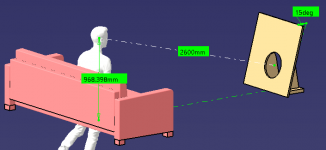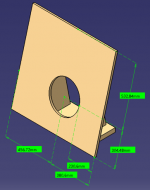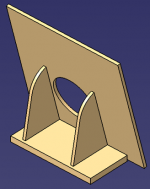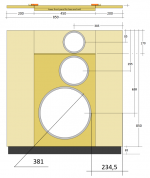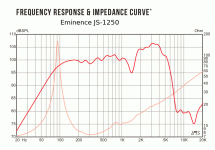Hello,
I'm designing a open baffle guitar cab and would like to have some feedback.
The cab will be used noodeling at home, sitting in the sofa see attached picture1.
Driver position is based on a relationship with 0,8:1:1,2:1,4 to baffle edges see attached picture2 and 3.
Shortest distance driver to baffle edge is 230mm see attached picture2 and is based on Troels OBL-15 "http://www.troelsgravesen.dk/OBL-15.htm".
Materials will be baltic birch ~20mm and a eminence js-1250 "https://www.eminence.com/speakers/speaker-detail/?model=JS_1250"
I'm designing a open baffle guitar cab and would like to have some feedback.
The cab will be used noodeling at home, sitting in the sofa see attached picture1.
Driver position is based on a relationship with 0,8:1:1,2:1,4 to baffle edges see attached picture2 and 3.
Shortest distance driver to baffle edge is 230mm see attached picture2 and is based on Troels OBL-15 "http://www.troelsgravesen.dk/OBL-15.htm".
Materials will be baltic birch ~20mm and a eminence js-1250 "https://www.eminence.com/speakers/speaker-detail/?model=JS_1250"
A really open, 'open back' speaker cab then!
Should fill your room with open and natural sound which will suit certain styles of guitar playing.
Expect lots of presence in the mid/high frequencies. The low end will not be emphasised, so I hope you're not intending to play Heavy Metal!
Should fill your room with open and natural sound which will suit certain styles of guitar playing.
Expect lots of presence in the mid/high frequencies. The low end will not be emphasised, so I hope you're not intending to play Heavy Metal!
Is there any reason not to use the classic 1x12 open back style box? Other than that a flat baffle is easier to build? I got recently two open backed cabs with Celestion G12H 30th anniversary speakers and they can do metal... without a bass guitar, they sound a bit anemic, but that is as it should be - in a band with bass they are just great. If I have a chance, I still use closed 2x12 or 4x12 box. However, if the stage space is limited, me and the other guitarist can happily use these.
This sounds like a fun experiment to try.I'm designing a open baffle guitar cab and would like to have some feedback.
If I were you, I would be very tempted to do a quick test using a large piece of cardboard, or a sheet of EPS (expanded polystyrene foam / Styrofoam), just to see how it sounds to your ears. As I'm sure you know, an open baffle doesn't have to be made of particularly strong or rigid material. You can temporarily duct-tape the speaker to the baffle for testing.
Like everyone else, I'm wondering whether you will have enough bass response to suit your tastes, or not. I agree that you don't need much bass from the guitar at all when there is a separate bass instrument, or for some types of solo guitar playing.
-Gnobuddy
Was stated in post #1. Here's a proper link: JS-1250 - Loudspeakers | Eminence Speaker
The traditional open-back cab really is just a folded baffle. With, as you say, the joyFor my application there are, in theory, no benefits to the tradi(ti)onal design.
I've found that throwing a cheap Walmart pillow into the cabinet helps to reduce audible boxiness a little bit, but you have to take care not to block cooling airflow to any valves sharing the cab with the speaker. The pillow idea works better with separate heads and cabs than with combo amplifiers.
Interestingly, for some rock-guitar genres, IMO a boxy-sounding cab seems to make the guitar sound better. The amp already has lots of midrange dialed in for those sounds, and additional boxy midrange resonances from the cab help to get the desired strong midrange emphasis that sounds so good when overdriven.
In the end, IMO, guitar is a very non-critical signal source; speaker frequency response problems that would be completely unacceptable for vocals are non-issues with guitar. I wouldn't be surprised at all if the frequency response of your chosen guitar speaker (see attached image) isn't much more erratic than the frequency response of the baffle itself!
-Gnobuddy
Attachments
IMO, anything which improves treble dispersion would be an improvement for guitar. The status quo is a piercingly bright timbre right on-axis, a dull and muffled tone far off axis, and, if you're lucky, a small listening area in between that sounds decent.i've seen karlsons used as bass cabs and have wondered if the dispersion characteristics would suit guitar?
Many years ago I tried a few tricks to disperse the treble better from full-range speakers, and the problem I ran into was this: if you take the existing narrow beam of treble, and spread it around, you then have less treble at any given location. The sound becomes duller. The more effectively the treble from a beamy speaker is dispersed, the duller the sound becomes - everywhere, at every listening location!
It's like taking the reflector off a flashlight. Removing the reflector gets you better dispersion - more uniform illumination - but less light in any given solid angle, because the same total energy has been dispersed over a wider angle. The same thing happens to the treble energy from the guitar speaker.
In the world of Hi-Fi speakers, designers talk of power response as well as frequency response. A speaker that narrowly beams treble will have very different frequency and power responses. And if you try to even out the power response of such a speaker, you end up with a droopy frequency response.
For Hi-Fi, the solution is to make the tweeter much smaller than the woofer, so that it has decent dispersion to start with (it's not beamy, in other words.) For guitar, that won't work by itself, because we want a huge peak in the speaker's frequency response in the 3 kHz - 4 kHz region, and that peak has traditionally been achieved by using a big flappy paper cone that breaks up at about that frequency.
I think there may be a way to eat your cake and have it too, but it will involve something much more complicated than just trying to un-beam a conventional beamy guitar speaker. One solution might be to use separate woofer and midrange speakers for guitar, with a passive crossover network designed to divide up the guitar signal, and also to make the treble response drop like a rock above 4 kHz or so. The midrange would have to be more electrically efficient than the woofer, to generate that midrange peak in the frequency response we want.
Maybe the more practical approach is the one we're now starting to see from guitarists with Kempers and Axe-FXs and Atomic Amps Amplifires - using a full-range, flat-response speaker (complete with tweeter, basically a P.A. speaker system), a powerful flat-response solid-state amplifier to drive it, and a speaker emulation filter somewhere in the guitar amp modeller. Not all of us are convinced these rigs sound good enough to replace real "toobs" in many genres of music, but they certainly do have better treble dispersion!
-Gnobuddy
We're Going Wrong?It's all wrong!
Sealed boxes (i.e. acoustic suspension enclosures) and ported bass-reflex boxes need to be rigid because the internal air pressure can be substantially different from the external air pressure at certain frequencies, and the box walls have to withstand the resulting forces.a very...rigid baffle
But open baffles? There is negligible pressure difference on the two sides of an open baffle, so it doesn't need to be rigid. All it needs is enough strength to stay flat, and to hold the speaker (reinforce locally as needed.)
Cardboard works just fine for an open baffle, and is acoustically dead (heavy internal mechanical damping), so it doesn't contribute nasty sounds of its own. Styrofoam works fine too, and also has heavy internal mechanical damping, but it tends to sound a little brighter, and may contribute some "whispery" sounds.
I've never tried foam-core board from the dollar store, but others on diyAudio have, and it possesses all the right mechanical characteristics, so I'm sure it will make good baffle material too.
I know that DIY speaker-obsessives want to gild every lily and revere every speaker design, but an open-baffle is basically a bit of light-hearted fun - a primitive, super-simple, completely non-critical way to get slightly better bass response - in exchange for erratic frequency response elsewhere - compared to an unmounted bare speaker.
-Gnobuddy
- Status
- This old topic is closed. If you want to reopen this topic, contact a moderator using the "Report Post" button.
- Home
- Live Sound
- Instruments and Amps
- Open baffle guitar cab – feedback wanted
